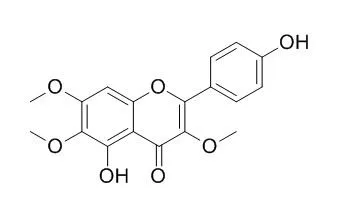| In vitro: |
| Eur J Pharm Sci. 2011 Oct 9;44(3):392-8. | | Inhibition of enterovirus 71 replication by chrysosplenetin and penduletin.[Pubmed: 21914477] | In recent years, enterovirus 71 (EV71) infections have caused an increasing epidemic in young children, accompanying with more severe nervous system disease and more deaths. Unfortunately, there is no specific medication for it so far.
METHODS AND RESULTS:
Here we investigated the anti-EV71 activity of chrysosplenetin and Penduletin, two o-methylated flavonols isolated from the leaves of Laggera pterodonta. These two compounds were found to have strong activity in vitro against EV71 with low cytotoxicity. In the cytopathic effect (CPE) inhibition assays, both plaque reduction assay and virus yield inhibition assay, the compounds showed a similar 50% inhibitory concentration (IC(50)) value of about 0.20 μM. The selectivity indices (SI) of chrysosplenetin and Penduletin were 107.5 and 655.6 in African green monkey kidney (Vero) cells, and 69.5 and 200.5 in human rhabdomyosarcoma (RD) cells, accordingly. The preliminary mechanism analysis indicates that they function not through blocking virus entry or inactivating virus directly but inhibiting viral RNA replication. In the time-of-addition assay, both compounds inhibited progeny virus production and RNA replication by nearly 100% when introduced within 4h post infection. In addition to EV71, both compounds inhibited several other human enteroviruses with similar efficacy.
CONCLUSIONS:
These findings provide a significant lead for the discovery of anti-EV71 drug. | | Oncol Res. 2005;15(2):59-68. | | Antineoplastic agents 540. The Indian Gynandropsis gynandra (Capparidaceae).[Pubmed: 16119003 ] | The CH3OH-CH2Cl2 extract of an Indian collection (entire plant) of Gynandropsis gynandra (L.) Briq. was separated based on bioassay results employing cancer cell lines.
METHODS AND RESULTS:
Six cancer cell growth inhibitors were isolated and found to be known flavone apegenin (4) and flavonols 1-3, 5, and 6. The structure of flavonol 2 was confirmed by X-ray crystal structure determination. All of the five flavonols (1-3, 5, 6) inhibited the murine P388 lymphocytic leukemia cell line with ED50 values of 3.0, 9.2, 4.0, 0.37, and 3.9 microg/ml, respectively.
CONCLUSIONS:
All six of the flavonoids (1-6) also exhibited activity against a panel of six human cancer cell lines. Penduletin (3) inhibited growth of the Gram-negative pathogen Neisseria gonorrhoeae and apegenin (4) inhibited growth of the Gram-positive opportunist Enterococcus faecalis. | | Planta Med. 2006 Jan;72(1):72-4. | | Flavonoids from Artemisia copa with anti-inflammatory activity.[Pubmed: 16450301 ] | Bioactivity-guided fractionation of the dichloromethane and ethanol extracts from the aerial parts of Artemisia copa led to the isolation of the flavonoids spinacetin, jaceosidin, axillarin, Penduletin, tricin and chrysoeriol.
METHODS AND RESULTS:
These compounds were studied for possible inhibitory activity on the generation of inflammatory mediators in a cell line of mouse macrophages (RAW 264.7) stimulated with lipopolysaccharide. Spinacetin and jaceosidin weakly inhibited nitric oxide production whereas all flavonoids reduced prostaglandin E2 levels to different extents. The most active flavonoid was jaceosidin that inhibited cyclooxygenase-2 activity in a concentration-dependent manner with an IC50 value of 2.8 microM. In addition, the other flavonoids partially inhibited synovial phospholipase A2 activity.
CONCLUSIONS:
These mechanisms may provide a basis for explaining the anti-inflammatory activity of this plant. |
|






 Cell. 2018 Jan 11;172(1-2):249-261.e12. doi: 10.1016/j.cell.2017.12.019.IF=36.216(2019)
Cell. 2018 Jan 11;172(1-2):249-261.e12. doi: 10.1016/j.cell.2017.12.019.IF=36.216(2019) Cell Metab. 2020 Mar 3;31(3):534-548.e5. doi: 10.1016/j.cmet.2020.01.002.IF=22.415(2019)
Cell Metab. 2020 Mar 3;31(3):534-548.e5. doi: 10.1016/j.cmet.2020.01.002.IF=22.415(2019) Mol Cell. 2017 Nov 16;68(4):673-685.e6. doi: 10.1016/j.molcel.2017.10.022.IF=14.548(2019)
Mol Cell. 2017 Nov 16;68(4):673-685.e6. doi: 10.1016/j.molcel.2017.10.022.IF=14.548(2019)